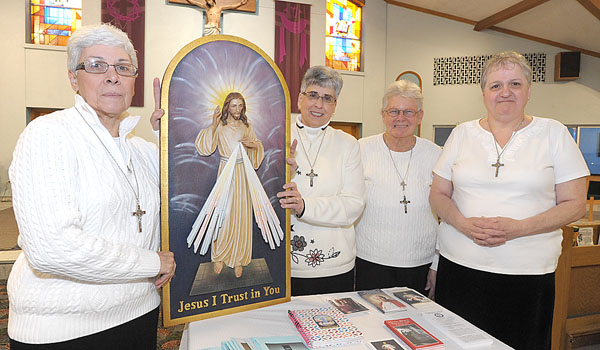Parish tradition ties in well with Divine Mercy Sunday
by KIMBERLEE SABSHIN
On Divine Mercy Sunday, April 3, St. Pius X Parish in Getzville will be tying a longstanding parish tradition in with the Holy Year of Mercy Pope Francis has declared. The parish will be offering confessions starting at 1:30 p.m., praying of the rosary at 2 p.m. and the Chaplet of Mercy at 2:45 p.m., and regular Mass at 3 p.m. After the Mass, the parish will be offering prayers for healing.
The novena of the Divine Mercy begins on Good Friday, March 25, and should be recited daily, preferably at 3 p.m. from then until Divine Mercy Sunday. However, it can also be recited all year long, as a novena, on a regular daily basis and for petitions of whatever is necessary.All these events are related to Pope Francis' declaration of a Holy Year of Mercy from Dec. 8, 2015, until Nov. 20, as well as St. Faustina and her efforts in promoting both Divine Mercy and the traditional praying of the chaplet in the faith.
The Divine Mercy Sunday Mass has been a tradition at St. Pius X for more than a decade. This year's celebrant will be Father Robert Wozniak. He will be joining five other confessors: Father Jay McGinnis, Father Douglas Faraci, Father James O'Connor, Father Arthur Smith and Msgr. James Kelly.
"We're extremely happy that it is the Year of Mercy and that we can play on the Divine Mercy Sunday Mass, because it's so highly significant," said Charlene McGraw, a parishioner of St. Pius X involved with the parish's Queen of Peace Healing Ministry. "Up to this year, we've tried to keep it pretty standard as to what we do and how we do it, because it's worked so well that we don't change too much."
The Queen of Peace Healing Ministry is McGraw, Joann Wander, Angie Bator and Maria Maraschiello. McGraw said the published diary of St. Maria Faustina Kowalska, "Divine Mercy in My Soul," includes accounts of visions the Polish nun had and messages about the mercy of Jesus Christ. St. Faustina was credited with inspiring the Divine Mercy movement. The book is available on Amazon.com.
"Before she came to do God's work, she was more worldly, and at one point in time, He said to her He was waiting for her," McGraw explained. "She started doing God's work and Our Lord asked that she have an image painted of Him, with the rays of mercy coming out, the white and the red for the blood and water of His Divine Mercy. There were multiple images made until the right one finally came up."
According to McGraw, "Divine Mercy in My Soul" also includes the history of St. Faustina's messages and what God asked of her. Although St. Faustina died of tuberculosis in 1938 at the young age of 33, she is honored today for her devotion to the Catholic faith, culminating in St. John Paul II canonizing her on April 30, 2000. Each year, Catholics continue to honor St. Faustina by celebrating her feast day on Oct. 5, and her legacy and what she did for Divine Mercy are a key part of the yearly celebration at St. Pius X.
"We have high respect for what she was trying to do and what she did in her life with the Divine Mercy, and so we basically just have the Mass and try to bring that out. Confessions are so important. We've never had any type of Mass without confessions, because that's where the mercy is," McGraw said.
McGraw also said many people have been drawn back to God and back to the Church largely because of the Divine Mercy Sunday Masses. She emphasized that since all of these have remained a longstanding tradition since long before Pope Francis declared the Year of Mercy, it was the Year of Mercy that played into the annual events that are held at St. Pius X, more so than the other way around.
McGraw noted that while many Catholics sometimes feel nothing can help with the troubles and problems in their lives, it is not the case. She said people have come back to confession after 40 or 50 years away from the Church. She cited one man coming back after 52 years, and the priest who heard his confession mentioning how much that day meant to him.
"People feel they can actually come back to their Jesus of Mercy, and that He is going to be here for them," she added. "No matter what it is that they are involved in or what they've done, where they've been, whatever their situation is in life, they know they can call on Jesus and He is such a merciful God, He is always there for us, and that plays into what the pope did with the door of mercy."
McGraw was referring to Pope Francis symbolically opening the holy door of St. Peter's Basilica to begin the Year of Mercy last December. Eight churches throughout the diocese have been designated with doors of mercy as part of the Year of Mercy. The churches include St. Joseph Cathedral in Buffalo; Our Lady of Victory in Lackawanna; St. Leo the Great Church in Amherst; St. Hyacinth Church, Blessed Mary Angela Parish, Dunkirk; St. Mary of the Angels in Olean; Our Lady of Mercy in LeRoy; Basilica of the National Shrine of Our Lady of Fatima in Youngstown; and Corpus Christi in Buffalo (from Palm Sunday through Corpus Christi Feast).




